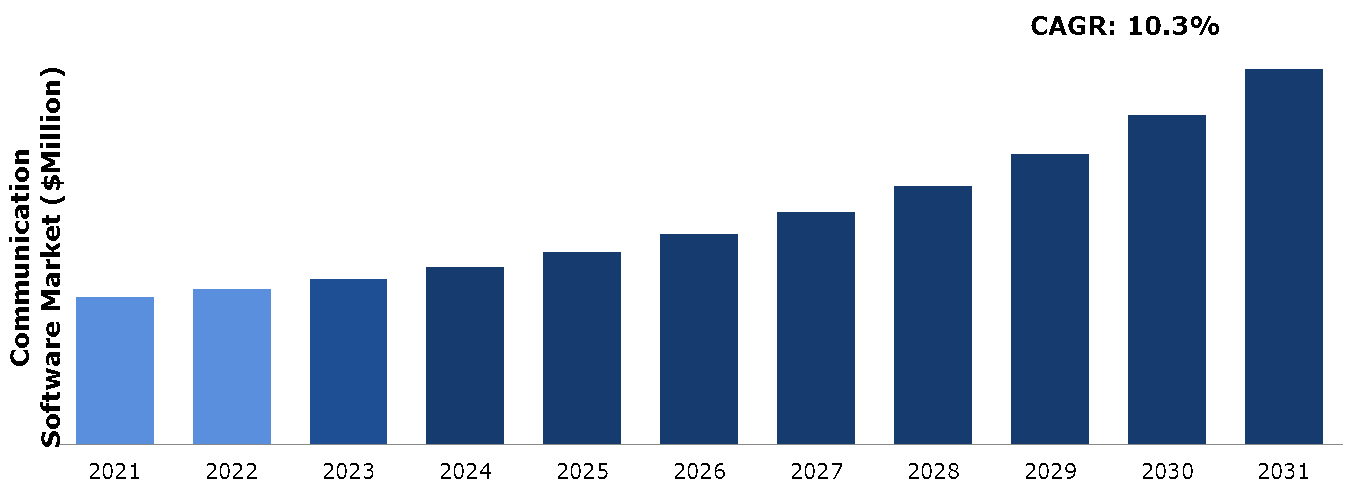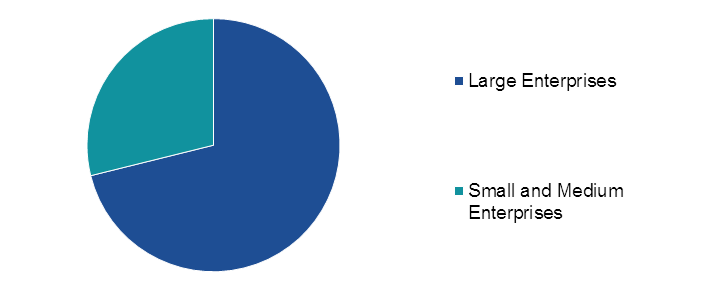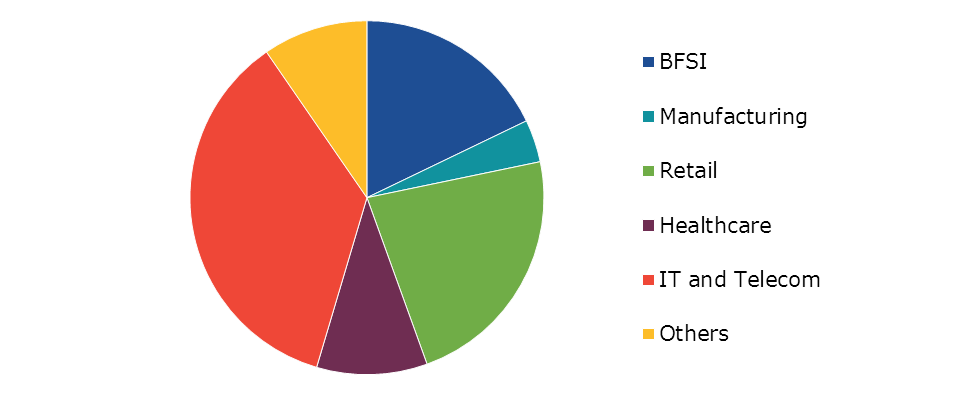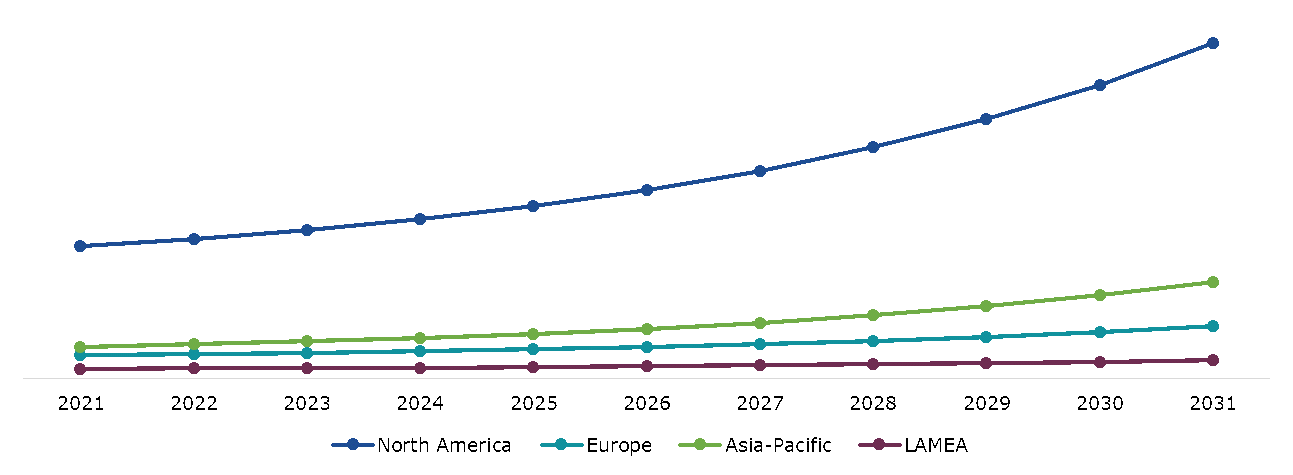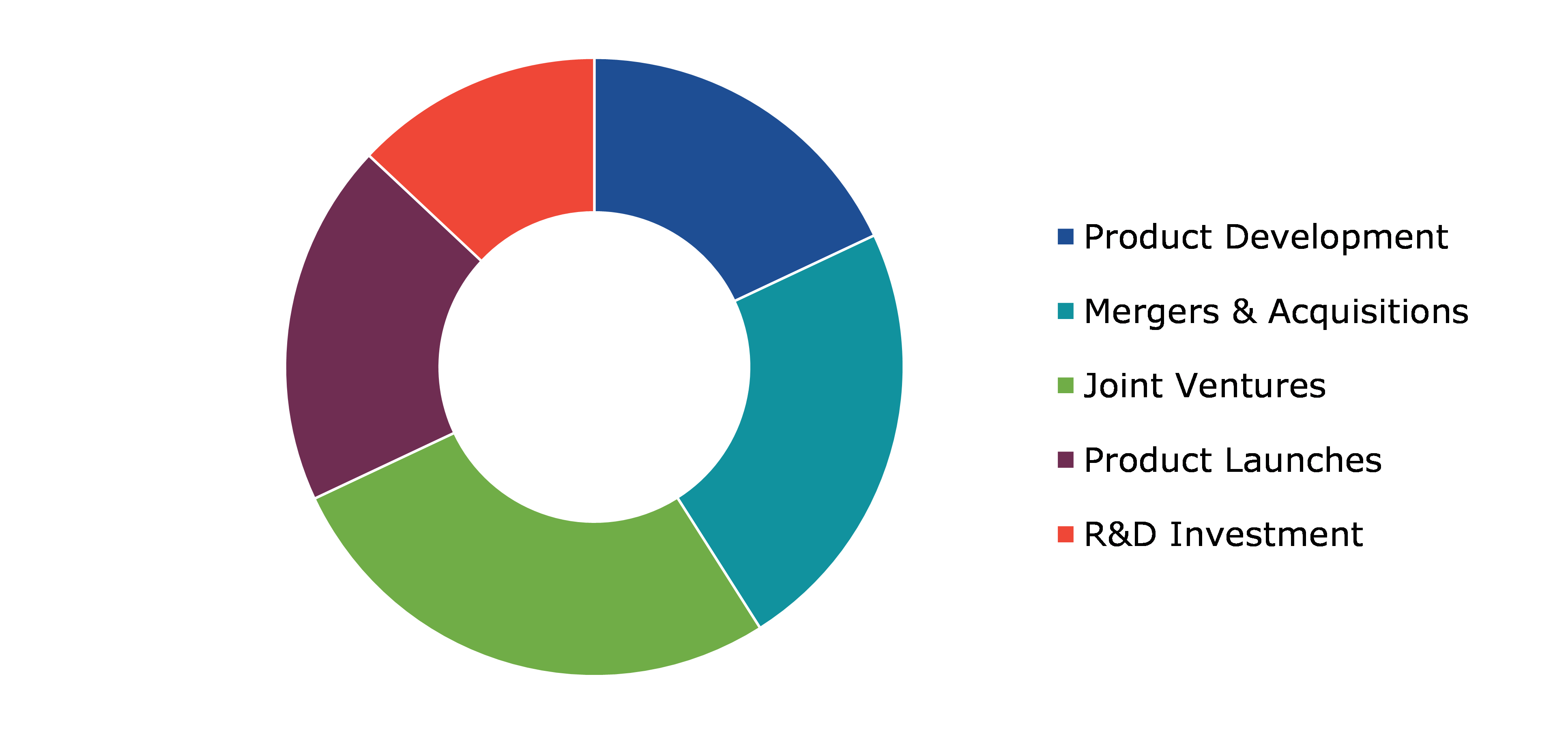Employee Communication Software Market Report
RA00088
Employee Communication Software Market, by Development Type (On-premises, Cloud), End use (Large Enterprises, Small & Medium Enterprises (SMEs)), Industry (BFSI, Healthcare, Manufacturing, IT & Telecom, Retail, Others), Regional Analysis (North America, Europe, Asia-Pacific, LA Employee Communication Software Market: Opportunity & Forecast 2026MEA): Global Opportunity Analysis and Industry Forecast, 2019–2026
Update Available On-Demand
Global Employee Communication Software Market Analysis
The Global Employee Communication Software Market Size was $1,001.9 million in 2021 and is predicted to grow with a CAGR of 10.3%, by generating a revenue of $2,550.5 million by 2031.
Global Employee Communication Software Market Synopsis
The growing demand for remote communication is one of the major growth factors of the employee communication software market. The demand for reliable and efficient communication solutions has increased as more firms implement remote work models. Regardless of where a team is located, employee communication software offers a variety of features, including instant messaging, video conferencing, file sharing, and project management. The COVID-19 pandemic has also boosted the use of remote work and emphasized the significance of digital communication technologies. The need for employee communication software has consequently grown even more. It has been necessary for many firms to quickly adjust to remote employment, and employee communication software has been a key component of this change. These factors are anticipated to boost the employee communication software market growth in the upcoming years.
High capital cost for the installation of employee communication software is restraining the growth of the market. Increasing security concerns about confidential organization information is also expected to hinder the growth of the market. Additionally, employee communication software is primarily reliant on technology and internet connectivity. Technical issues such as poor audio or video quality, dropped calls, or software glitches can disrupt conversation and cause difficulties.
The employee communication software market is expanding as businesses need more efficient and effective communication tools. Cloud-based communication solutions, which have several advantages over traditional on-premises systems, are a primary driver of this expansion. The cloud-based employee communication software is adaptable and scalable. Users may use communication tools from any place and on any device with cloud-based solutions, making them perfect for remote work and collaboration. This enables businesses to simply increase their communication capabilities as needed, without worrying about infrastructure constraints or the expenses associated with maintaining on-premises systems.
According to regional analysis, the North America employee communication software market analysis accounted for the highest market share in 2021. The employee communication software market demand in North America was primarily driven by growth factors such as the high adoption of advanced communication technologies, the presence of a large number of employee communication software vendors, and the increasing demand for cloud-based communication solutions.
Employee Communication Software Overview
Employee communication software refers to any software application or platform that facilitates communication between two or more users. It enables people to interact and exchange information through a digital medium, such as text messages, voice calls, video calls, emails, and instant messaging. Software for communication comes with a wide range of possibilities. The program's primary unique feature is its ability to transmit data across other parties or devices. Utilizing employee communication software creates a network that makes it simple to identify and manage devices, which is its main advantage. Information may thus be shared between different departments and employees more efficiently due to these devices.
COVID-19 Impact on Global Employee Communication Software Market
The COVID-19 pandemic has had a significant impact on the employee communication software market, as it has accelerated the adoption of remote work and virtual communication tools. Increased demand for video conferencing tools like Zoom, Microsoft Teams, and Google Meet has been the pandemic's biggest effect on the market for communications software. These platforms have become important resources for virtual meetings and collaboration as individuals have shifted to remote working. The rising usage of cloud-based communication solutions is another trend that has developed during the pandemic. Greater flexibility and scalability are made possible by cloud software, which is crucial as businesses try adjusting to shifting business environments.
Teams now need to collaborate and communicate remotely, so collaboration tools like Slack, Trello, and Asana are more crucial than ever. Despite the implementation of physical distance during the pandemic, these tools have aided in maintaining teamwork and productivity.
The market for employee communication software has seen a mixed impact of COVID-19. While some businesses have experienced significant growth, others face difficulties. But it's likely that demand for employee communication software will increase as remote work becomes more prevalent.
Growing Demand for Remote Collaboration to Drive the Market Growth
Businesses increasingly utilize communication technologies to support collaboration and sustain productivity as remote work and distributed teams become more common. For distant teams to conduct virtual meetings and conversations, video conferencing solutions like Zoom, Microsoft Teams, and Google Meet have become crucial resources. Slack and Microsoft Teams are two examples of instant messaging applications. In addition, remote teams may successfully coordinate and monitor their work, assign tasks, and collaborate on projects with the use of project management platforms like Trello, Asana, and Monday.com. As remote work grows more common, demand for all these employee communication software solutions, which are essential for keeping remote teams connected and productive, is anticipated to increase.
To know more about global Employee Communication Software market drivers, get in touch with our analysts here.
Security Concern to Restrain the Market Growth
Security is a major concern for users of employee communication software, especially in the business and government sectors. The need for secure employee communication software is crucial to protect sensitive information from potential breaches, cyber-attacks, and other security threats. Organizations must ensure that their employee communication software meets the necessary security standards and protocols to safeguard their data and maintain their reputation and financial stability. The concern for security has, in fact, led to a higher demand for secure employee communication software, which has led to the development of advanced encryption and security features. However, the need for enhanced security also adds to the complexity and cost of developing and maintaining employee communication software, which is anticipated to hamper the employee communication software market growth.
Advancements in Technology to Drive Excellent Opportunities
Companies providing employee communication software can benefit from utilizing cutting-edge technology like blockchain, machine learning, and artificial intelligence to boost their goods and services. Using chatbots to answer consumer questions or virtual assistants to organize meetings and give reminders are just two examples of how AI can be used to automate communication duties. AI can be used to analyze communication data and produce insights that help with bettering communication plans and results. ML can be used to improve call quality or decrease latency in communication networks. Additionally, it can be used to tailor communication experiences, for example, by proposing pertinent information or goods based on user behavior. Using blockchain technology, communication security and privacy can be improved. For instance, messaging apps built on blockchain technology can offer end-to-end encryption and guard against data leaks.
To know more about global employee communication software market opportunities, get in touch with our analysts here.
Global Employee Communication Software Market, by Deployment Model
Based on deployment model, the market has been divided into cloud and on-premises. Among these, the cloud sub-segment accounted for the highest market share in 2021 and is estimated to show the fastest growth during the forecast period.
Global Employee Communication Software Market Size, by Deployment Model, 2021
Source: Research Dive Analysis
The cloud sub-type accounted for the highest market share in 2021 and is estimated to show the fastest growth during the forecast period. There has been an increased number of employees working remotely, and thus the demand for cloud-based platforms for efficient team collaboration across companies has seen a rise. Additionally, these cloud platforms give users the freedom to access teamwork tools via smartphones, which have improved features, such as the ability to record events for later review.
The spread of cloud-based communication technologies, like instant messaging software and video conferencing tools, to enable efficient communication between enterprises while the employees work remotely, has been greatly aided by the COVID-19 pandemic. Cloud-based systems enable remote teams to manage projects of all sizes and streamline their company operations.
Global Employee Communication Software Market, by Enterprise Size
Based on enterprise size, the market has been divided into large enterprises and small & medium enterprises. Among these, the large enterprises sub-segment accounted for highest revenue share in 2021.
Global Employee Communication Software Market Trends, by Enterprise Size, 2021
Source: Research Dive Analysis
The large enterprises sub-segment accounted for the highest employee communication software market share in 2021. Large enterprises have a higher need for collaboration due to their size, complexity, and global nature. employee communication software enables employees to collaborate seamlessly, share information, and work together towards a common goal. Employee communication software helps large enterprises to improve their efficiency by streamlining communication channels and reducing the time and effort required for communication. This leads to faster decision-making, increased productivity, and reduced operational costs. Large enterprises handle a significant amount of sensitive information. Employee communication software providers are aware of this and are investing heavily in security measures to protect their customers' data. Large enterprises prioritize security when selecting employee communication software and are willing to pay more for software that offers robust security features. These factors are anticipated to boost the growth of large enterprises sub-segment during the analysis timeframe.
Global Employee Communication Software Market, by Industry Vertical
Based on industry vertical, the market has been divided into BFSI, manufacturing, retail, healthcare, IT & telecom, and others. Among these, the IT & Telecom sub-segment accounted for highest revenue share in 2021.
Global Employee Communication Software Market Share, by Industry Vertical, 2021
Source: Research Dive Analysis
The IT & telecom sub-segment accounted for the highest employee communication software market share in 2021. Employee communication software refers to applications and systems that enable communication and collaboration between individuals or groups, regardless of their location or device. The IT and telecom sector is responsible for the development and deployment of employee communication software that is used by businesses and consumers worldwide. There are several factors that contribute to the growth of the IT and telecom segment in the employee communication software market. One of the main drivers is the increasing demand for employee communication software that can support remote work and collaboration. With more people working remotely due to the COVID-19 pandemic, the need for reliable and secure employee communication software has become more important than ever before. These factors are anticipated to boost the growth of IT and telecom sub-segment during the analysis timeframe.
Global Employee Communication Software Market, Regional Insights
The Employee communication software market was investigated across North America, Europe, Asia-Pacific, and LAMEA.
Global Employee Communication Software Market Size & Forecast, by Region, 2021-2031 (USD Million)
Source: Research Dive Analysis
The Market for Employee Communication Software in North America was the Most Dominant
The North America employee communication software market size accounted for the highest market share in 2021. North America is known for its highly advanced technology and infrastructure. This has led to a high demand for employee communication software that can facilitate easy communication and collaboration among businesses and individuals. The shift towards cloud-based solutions has been significant in North America. This has led to a high demand for employee communication software that can be accessed remotely from anywhere, at any time. The need for UC & C (Unified Communications and Collaboration) solutions that can integrate various communication channels, such as voice, video, messaging, and collaboration tools, has been on the rise in North America. This has led to an increase in the demand for employee communication software that can provide these functionalities.
North America has a high penetration rate of mobile devices, including smartphones and tablets. This has led to a high demand for employee communication software that can be used on these devices, allowing for easy and convenient communication on the go. The COVID-19 pandemic has accelerated the trend towards remote work in North America. This has led to a high demand for employee communication software that can facilitate remote collaboration, video conferencing, and virtual meetings.
Competitive Scenario in the Global Employee Communication Software Market
Investment and agreement are common strategies followed by major market players. For instance, in June 22, 2022, Axonify, a leader in frontline employee training and communications, announced the acquisition of Nudge, a top-rated employee communication and execution platform. This strategic union will simplify frontline team enablement and offer best-in-class tools for frontline-devoted organizations.
Source: Research Dive Analysis
Some of the leading employee communication software market players are Nudge Rewards Inc.,GuideSpark, Beekeeper AG, Sociabble, Inc.,SocialChorus. Inc., Poppulo,OurPeople, Smarp, theemployeeapp, and Workvivo Limited.
| Aspect | Particulars |
| Historical Market Estimations | 2019-2020 |
| Base Year for Market Estimation | 2021 |
| Forecast Timeline for Market Projection | 2022-2031 |
| Geographical Scope | North America, Europe, Asia-Pacific, LAMEA |
| Segmentation by Deployment Model |
|
| Segmentation by Enterprise Size |
|
|
Segmentation by Industry Vertical
|
|
| Key Companies Profiled |
|
Q1. What is the size of the global Employee Communication Software market?
A. The size of the global employee communication software market was over $1,001.9 million in 2021 and is projected to reach $2,550.5 million by 2031.
Q2. Which are the major companies in the employee communication software market?
A. Nudge Rewards Inc. and GuideSpark are some of the key players in the global employee communication software market.
Q3. Which region, among others, possesses greater investment opportunities in the near future?
A. The Asia-Pacific region possesses great investment opportunities for investors to witness the most promising growth in the future.
Q4. What will be the growth rate of the Asia-Pacific employee communication software market?
A. Asia-Pacific employee communication software market is anticipated to grow at 12.2% CAGR during the forecast period.
Q5. What are the strategies opted by the leading players in this market?
A. Agreement and investment are the two key strategies opted by the operating companies in this market.
Q6. Which companies are investing more on R&D practices?
A. Beekeeper AG, Sociabble, Inc., and Social Chorus. Inc. are the companies investing more on R&D activities for developing new products and technologies.
1.Research Methodology
1.1.Desk Research
1.2.Real time insights and validation
1.3.Forecast model
1.4.Assumptions and forecast parameters
1.5.Market size estimation
1.5.1.Top-down approach
1.5.2.Bottom-up approach
2.Report Scope
2.1.Market definition
2.2.Key objectives of the study
2.3.Report overview
2.4.Market segmentation
2.5.Overview of the impact of COVID-19 on Global employee communication software market
3.Executive Summary
4.Market Overview
4.1.Introduction
4.2.Growth impact forces
4.2.1.Drivers
4.2.2.Restraints
4.2.3.Opportunities
4.3.Market value chain analysis
4.3.1.List of raw material suppliers
4.3.2.List of manufacturers
4.3.3.List of distributors
4.4.Innovation & sustainability matrices
4.4.1.Technology matrix
4.4.2.Regulatory matrix
4.5.Porter’s five forces analysis
4.5.1.Bargaining power of suppliers
4.5.2.Bargaining power of consumers
4.5.3.Threat of substitutes
4.5.4.Threat of new entrants
4.5.5.Competitive rivalry intensity
4.6.PESTLE analysis
4.6.1.Political
4.6.2.Economical
4.6.3.Social
4.6.4.Technological
4.6.5.Environmental
4.7.Impact of COVID-19 on employee communication software market
4.7.1.Pre-covid market scenario
4.7.2.Post-covid market scenario
5.Employee Communication Software Market Analysis, by Deployment Model
5.1.Overview
5.2.Cloud
5.2.1.Definition, key trends, growth factors, and opportunities
5.2.2.Market size analysis, by region, 2021-2031
5.2.3.Market share analysis, by country, 2021-2031
5.3.On-Premises
5.3.1.Definition, key trends, growth factors, and opportunities
5.3.2.Market size analysis, by region, 2021-2031
5.3.3.Market share analysis, by country, 2021-2031
5.4.Research Dive Exclusive Insights
5.4.1.Market attractiveness
5.4.2.Competition heatmap
6.Employee Communication Software Market Analysis, by Enterprise Size
6.1.Large Enterprises
6.1.1.Definition, key trends, growth factors, and opportunities
6.1.2.Market size analysis, by region, 2021-2031
6.1.3.Market share analysis, by country, 2021-2031
6.2.Small and Medium Enterprises
6.2.1.Definition, key trends, growth factors, and opportunities
6.2.2.Market size analysis, by region, 2021-2031
6.2.3.Market share analysis, by country, 2021-2031
6.3.Research Dive Exclusive Insights
6.3.1.Market attractiveness
6.3.2.Competition heatmap
7.Employee Communication Software Market Analysis, by Industry Vertical
7.1.BFSI
7.1.1.Definition, key trends, growth factors, and opportunities
7.1.2.Market size analysis, by region, 2021-2031
7.1.3.Market share analysis, by country, 2021-2031
7.2.Manufacturing
7.2.1.Definition, key trends, growth factors, and opportunities
7.2.2.Market size analysis, by region, 2021-2031
7.2.3.Market share analysis, by country, 2021-2031
7.3.Retail
7.3.1.Definition, key trends, growth factors, and opportunities
7.3.2.Market size analysis, by region, 2021-2031
7.3.3.Market share analysis, by country, 2021-2031
7.4.Healthcare
7.4.1.Definition, key trends, growth factors, and opportunities
7.4.2.Market size analysis, by region, 2021-2031
7.4.3.Market share analysis, by country, 2021-2031
7.5.IT and Telecom
7.5.1.Definition, key trends, growth factors, and opportunities
7.5.2.Market size analysis, by region, 2021-2031
7.5.3.Market share analysis, by country, 2021-2031
7.6.Others
7.6.1.Definition, key trends, growth factors, and opportunities
7.6.2.Market size analysis, by region, 2021-2031
7.6.3.Market share analysis, by country, 2021-2031
7.7.Research Dive Exclusive Insights
7.7.1.Market attractiveness
7.7.2.Competition heatmap
8.Employee Communication Software Market, by Region
8.1.North America
8.1.1.U.S.
8.1.1.1.Market size analysis, by Deployment Model, 2021-2031
8.1.1.2.Market size analysis, by Enterprise Size, 2021-2031
8.1.1.3.Market size analysis, by Industry Vertical, 2021-2031
8.1.2.Canada
8.1.2.1.Market size analysis, by Deployment Model, 2021-2031
8.1.2.2.Market size analysis, by Enterprise Size, 2021-2031
8.1.2.3.Market size analysis, by Industry Vertical, 2021-2031
8.1.3.Mexico
8.1.3.1.Market size analysis, by Deployment Model, 2021-2031
8.1.3.2.Market size analysis, by Enterprise Size, 2021-2031
8.1.3.3.Market size analysis, by Industry Vertical, 2021-2031
8.1.4.Research Dive Exclusive Insights
8.1.4.1.Market attractiveness
8.1.4.2.Competition heatmap
8.2.Europe
8.2.1.Germany
8.2.1.1.Market size analysis, by Deployment Model, 2021-2031
8.2.1.2.Market size analysis, by Enterprise Size, 2021-2031
8.2.1.3.Market size analysis, by Industry Vertical, 2021-2031
8.2.2.UK
8.2.2.1.Market size analysis, by Deployment Model, 2021-2031
8.2.2.2.Market size analysis, by Enterprise Size, 2021-2031
8.2.2.3.Market size analysis, by Industry Vertical, 2021-2031
8.2.3.France
8.2.3.1.Market size analysis, by Deployment Model, 2021-2031
8.2.3.2.Market size analysis, by Enterprise Size, 2021-2031
8.2.3.3.Market size analysis, by Industry Vertical, 2021-2031
8.2.4.Spain
8.2.4.1.Market size analysis, by Deployment Model, 2021-2031
8.2.4.2.Market size analysis, by Enterprise Size, 2021-2031
8.2.4.3.Market size analysis, by Industry Vertical, 2021-2031
8.2.5.Italy
8.2.5.1.Market size analysis, by Deployment Model, 2021-2031
8.2.5.2.Market size analysis, by Enterprise Size, 2021-2031
8.2.5.3.Market size analysis, by Industry Vertical, 2021-2031
8.2.6.Rest of Europe
8.2.6.1.Market size analysis, by Deployment Model, 2021-2031
8.2.6.2.Market size analysis, by Enterprise Size, 2021-2031
8.2.6.3.Market size analysis, by Industry Vertical, 2021-2031
8.2.7.Research Dive Exclusive Insights
8.2.7.1.Market attractiveness
8.2.7.2.Competition heatmap
8.3.Asia Pacific
8.3.1.China
8.3.1.1.Market size analysis, by Deployment Model, 2021-2031
8.3.1.2.Market size analysis, by Enterprise Size, 2021-2031
8.3.1.3.Market size analysis, by Industry Vertical, 2021-2031
8.3.2.Japan
8.3.2.1.Market size analysis, by Deployment Model, 2021-2031
8.3.2.2.Market size analysis, by Enterprise Size, 2021-2031
8.3.2.3.Market size analysis, by Industry Vertical, 2021-2031
8.3.3.India
8.3.3.1.Market size analysis, by Deployment Model, 2021-2031
8.3.3.2.Market size analysis, by Enterprise Size, 2021-2031
8.3.3.3.Market size analysis, by Industry Vertical, 2021-2031
8.3.4.Australia
8.3.4.1.Market size analysis, by Deployment Model, 2021-2031
8.3.4.2.Market size analysis, by Enterprise Size, 2021-2031
8.3.4.3.Market size analysis, by Industry Vertical, 2021-2031
8.3.5.South Korea
8.3.5.1.Market size analysis, by Deployment Model, 2021-2031
8.3.5.2.Market size analysis, by Enterprise Size, 2021-2031
8.3.5.3.Market size analysis, by Industry Vertical, 2021-2031
8.3.6.Rest of Asia Pacific
8.3.6.1.Market size analysis, by Deployment Model, 2021-2031
8.3.6.2.Market size analysis, by Enterprise Size, 2021-2031
8.3.6.3.Market size analysis, by Industry Vertical, 2021-2031
8.3.7.Research Dive Exclusive Insights
8.3.7.1.Market attractiveness
8.3.7.2.Competition heatmap
8.4.LAMEA
8.4.1.Brazil
8.4.1.1.Market size analysis, by Deployment Model, 2021-2031
8.4.1.2.Market size analysis, by Enterprise Size, 2021-2031
8.4.1.3.Market size analysis, by Industry Vertical, 2021-2031
8.4.2.Saudi Arabia
8.4.2.1.Market size analysis, by Deployment Model, 2021-2031
8.4.2.2.Market size analysis, by Enterprise Size, 2021-2031
8.4.2.3.Market size analysis, by Industry Vertical, 2021-2031
8.4.3.UAE
8.4.3.1.Market size analysis, by Deployment Model, 2021-2031
8.4.3.2.Market size analysis, by Enterprise Size, 2021-2031
8.4.3.3.Market size analysis, by Industry Vertical, 2021-2031
8.4.4.South Africa
8.4.4.1.Market size analysis, by Deployment Model, 2021-2031
8.4.4.2.Market size analysis, by Enterprise Size, 2021-2031
8.4.4.3.Market size analysis, by Industry Vertical, 2021-2031
8.4.5.Rest of LAMEA
8.4.5.1.Market size analysis, by Deployment Model, 2021-2031
8.4.5.2.Market size analysis, by Enterprise Size, 2021-2031
8.4.5.3.Market size analysis, by Industry Vertical, 2021-2031
8.4.6.Research Dive Exclusive Insights
8.4.6.1.Market attractiveness
8.4.6.2.Competition heatmap
9.Competitive Landscape
9.1.Top winning strategies, 2021
9.1.1.By strategy
9.1.2.By year
9.2.Strategic overview
9.3.Market share analysis, 2021
10.Company Profiles
10.1.Nudge Rewards Inc.
10.1.1.Overview
10.1.2.Business segments
10.1.3.Product portfolio
10.1.4.Financial performance
10.1.5.Recent developments
10.1.6.SWOT analysis
10.2.GuideSpark
10.2.1.Overview
10.2.2.Business segments
10.2.3.Product portfolio
10.2.4.Financial performance
10.2.5.Recent developments
10.2.6.SWOT analysis
10.3.Beekeeper AG
10.3.1.Overview
10.3.2.Business segments
10.3.3.Product portfolio
10.3.4.Financial performance
10.3.5.Recent developments
10.3.6.SWOT analysis
10.4.Sociabble, Inc.
10.4.1.Overview
10.4.2.Business segments
10.4.3.Product portfolio
10.4.4.Financial performance
10.4.5.Recent developments
10.4.6.SWOT analysis
10.5.SocialChorus. Inc.
10.5.1.Overview
10.5.2.Business segments
10.5.3.Product portfolio
10.5.4.Financial performance
10.5.5.Recent developments
10.5.6.SWOT analysis
10.6.Poppulo
10.6.1.Overview
10.6.2.Business segments
10.6.3.Product portfolio
10.6.4.Financial performance
10.6.5.Recent developments
10.6.6.SWOT analysis
10.7.OurPeople
10.7.1.Overview
10.7.2.Business segments
10.7.3.Product portfolio
10.7.4.Financial performance
10.7.5.Recent developments
10.7.6.SWOT analysis
10.8.Smarp
10.8.1.Overview
10.8.2.Business segments
10.8.3.Product portfolio
10.8.4.Financial performance
10.8.5.Recent developments
10.8.6.SWOT analysis
10.9.theemployeeapp
10.9.1.Overview
10.9.2.Business segments
10.9.3.Product portfolio
10.9.4.Financial performance
10.9.5.Recent developments
10.9.6.SWOT analysis
10.10.Workvivo Limited
10.10.1.Overview
10.10.2.Business segments
10.10.3.Product portfolio
10.10.4.Financial performance
10.10.5.Recent developments
10.10.6.SWOT analysis
In today’s fast-paced business world, efficient communication is critical to any organization's success. Whether it is conveying important data, coordinating initiatives, or promoting team collaboration, effective communication is critical. However, with the rising complexity and size of modern enterprises, traditional methods of communication frequently fall short. This is where the employee communication software solution comes in.
The employee communication software market is continuously evolving with new technologies and trends. The employee communication software is any software application or platform that allows two or more people to communicate with one another. It allows people to communicate and exchange information by digital means such as text messages, voice conversations, emails, video calls, and instant messaging. Software for communication has a wide range of capabilities. The program's key unique feature is its capacity to send data to other parties or devices. The primary benefit of using employee communication software is that it creates a network, which makes it easy to identify and manage devices. As a result of these devices, information may be shared more efficiently among departments and personnel.
Recent Trends in the Employee Communication Software Market
With the increasing amount of sensitive data shared internally, security and privacy have become key concerns. Employee communication software suppliers are working on incorporating strong security measures like data encryption, access limits, and compliance with requirements such as GDPR (General Data Protection Regulation). Additionally, organizations know how important it is to maintain employee engagement and connection. Employee communication software is expanding to incorporate features that promote teamwork, feedback, and recognition. Gamification, polls, and social features are being implemented into platforms to increase involvement.
Newest Insights in the Employee Communication Software Market
As per a report by Research Dive, the global employee communication software market is expected to grow at a CAGR of 10.3% and generate revenue of $2,550.5 million by 2031. The primary factors driving the growth of the market are the growing demand for reliable and effective communication solutions, the increasing need for remote communication, and the rising technological advancement. However, the expensive capital expenditures required to implement employee communication software are expected to hinder the market growth.
The employee communication software market in North America is expected to remain dominant in the coming years. The region's high revenue in 2021 was driven by a large number of vendors providing employee communication software, widespread use of innovative communication technology, and rising interest in cloud-based communication solutions. This has led to an increased demand for efficient and effective communication within organizations.
How are Market Players Responding to the Rising Demand for Employee Communication Software?
Market players are responding to the rising demand for employee communication software by investing in research and development to create more innovative and efficient solutions. They are also expanding their product portfolios and purchasing smaller companies to strengthen their position in the employee communication software market.
In addition, market players are increasingly focusing on strategic partnerships and collaborations with other players in the industry to leverage their strengths and expand their reach. Some of the foremost players in the employee communication software market are GuideSpark, Workvivo Limited, Nudge Rewards Inc., Sociabble, Inc., SocialChorus. Inc., Beekeeper AG, Poppulo, OurPeople, the employee app, Smarp, and others. These players are focused on implementing strategies such as mergers and acquisitions, novel developments, collaborations, and partnerships to reach a leading position in the global market.
For instance:
- In August 2020, Hexaware Technologies Limited, one of the top providers of consulting and digital solutions in the world, announced a collaboration with Freshworks Inc., a customer engagement software company, to develop digital solutions to boost customer and employee engagement
- In January 2022, Tucows, a leading supplier of internet services, announced the opening of Wavelo, its newest business. The new company delivers accessible telecom software to CSPs (communication service providers) worldwide, reducing network barriers and enhancing internet access globally.
- In March 2023, ChangeEngine, the innovative workplace technology solution that helps businesses to plan, find, and deliver the employee moments that matter most, launched Communication Library, an open platform to quickly brand and design staff communications.
COVID-19 Impact on the Global Employee Communication Software Market
The COVID-19 pandemic had a positive impact on the global employee communication software market. The pandemic increased the usage of virtual communication and remote work tools. The rise of pandemic resulted in increased demand for communication software and video conferencing products like Microsoft Teams, Zoom, and Google Meet. As more people migrated to remote working, these platforms grown into crucial resources for online meetings and collaboration. Another trend that emerged during the crisis period is the increased use of cloud-based communication systems. Cloud software enables greater flexibility and scalability, which is essential as firms try to adapt to changing business conditions. Teams increasingly need to cooperate and communicate remotely, thus collaboration platforms like Slack, Trello, and Asana became more important than ever. These factors significantly fueled the employee communication software market growth amidst the pandemic.
Personalize this research
- Triangulate with your own data
- Request your format and definition
- Get a deeper dive on a specific application, geography, customer or competitor
- + 1-888-961-4454 Toll - Free
- support@researchdive.com

